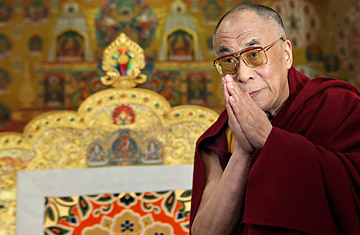
The Dalai Lama in Dharamsala, India.
A year ago the Chinese government was caught off-guard by an uprising by Tibetan activists. Text messages and blogs among Tibetans in exile and compatriots in their Himalayan homeland helped coordinate and cheer on an uprising that embarrassed the rulers of the People's Republic as China just as the country was preparing for its Olympics. A year later, however, the Chinese authorities have moved with dispatch to prevent any recurrence. In the run-up to Mar. 10, the 50th anniversary of the Dalai Lama's escape from Tibet after a failed uprising, Beijing has cut off communication between Tibet—as well as areas with large ethnic Tibetan communities—and the rest of the world. (See pictures of last year's uprising in Tibet.)
With access denied, pro-Tibet activists have been left with a trickle of information — mostly nebulous or incomplete. "We're hoping, rather ominously, for some news," says Tenzin Tsundue, a prominent writer and Tibet independence activist in Dharamsala, site of the Dalai Lama's government-in-exile. The last piece of news came on February 25, with a phone call from the Aba region, a largely ethnic Tibetan community in China's Sichuan province, that indicated that a monk had set himself on fire.(See pictures of the Dalai Lama's spiritual journey.)
"Landlines in Tibet are all down," says Jigme Worbu, who works as a phone booth operator for the exiled government. "Though sometimes it's possible to get through on mobile phones." On the wall is a list of telephone codes for various Tibetan regions, and four clocks charting the time in India, Tibet, the U.S. and Europe. He says some 20 people drop by to call Tibet from his phone booths every day. Conversation is cryptic at best, with callers avoiding names and any references that might land those in Tibet in trouble with the authorities. "No one's talking. They're scared their phones may be tapped," says Worbu.
Tenzin Losel of International Campaign for Tibet spends several hours each day scouring Chinese websites and blogs for information on the goings-on in Tibet. "It's the internet that has been of most use to us," he says. "We try everything, from Google to Chinese tourist blogs," he says, "Sometimes tourists might reveal, say, how many troops they saw during a visit to Potala Palace. Sometimes Chinese news reports unwittingly let out details such as how China has handled protests." But Chinese authorities have been policing the Net heavily since the protests last March, and many blogs and sites have been blocked. One of the casualties has been www.tibetcult.com, a website officially sanctioned by the Chinese government, which hosted several Tibetan bloggers who mostly adhered to official restrictions (with the occasional sly cross-over into risky commentary.) After March 5, searches for www.tibetcult.com either failed to load or brought up a sign that said it was undergoing "maintenance."
Tibetan exiles in Dharamsala hate Xizang TV — the propaganda channel in the Tibetan language operated by Beijing — yet hardly anyone misses a show. "It's the only place you can hear Tibetan and see Tibet," says Tsundue. They also take solace in the music of two singers who work in Chinese-occupied Tibet and whose CD's are hot sellers: Yadong, who sings of the beauty of his homeland, and Kunga, a young heartthrob loved as much for his voice as for his boyish good looks. "Their lyrics are very clever," says Losel. "They might seem to sing of natural beauty, but often there's a hint of loyalty to His Holiness [the Dalai Lama], or of brotherhood between Tibetans around the world, or such issues that the Chinese government does not allow you to talk about." (See pictures of Tibet's struggle to maintain its Buddhist traditions.)
With little clue to the situation inside Tibet, the mood on Dharamsala's streets is muted. A handful of protesters are selling yellow-and-maroon Tibetan flags ahead of demonstrations scheduled for Tuesday. A few youngsters on motor-bikes are cruising around hoisting flags, and a lone painter is making a black-and-white sign reading "Tibet: One Struggle, One Nation" near the Namgyal monastery that forms the heart of the town. But there's none of the optimism and the energy of last year. "Last year's protests pushed the Tibet issue to the top of the international news agenda," says Kate Saunders of ICT, "The elaborate preparations this time show that if nothing else, at least the Chinese government has been forced to face the fact that the international community disapproves of the way it handled the protests."
